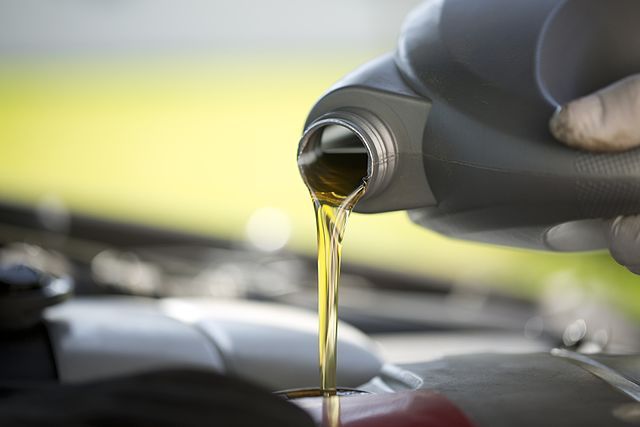


In the pursuit of sustainable practices, the automotive industry has been actively seeking eco-friendly alternatives to traditional petroleum-based lubricants. These innovative lubricants offer a game-changing approach to reducing environmental impact while providing superior performance and operational efficiency. This comprehensive article will delve into the various types of environmentally-friendly lubricants, their benefits, challenges, and the future outlook of this rapidly growing field within the automotive sector.

The automotive industry has long been a significant contributor to environmental pollution, with lubricants playing a crucial role in the operation of vehicles. Traditional petroleum-based lubricants pose a significant threat to the environment due to their non-biodegradable nature and potential for soil and water contamination. As environmental awareness continues to grow, the demand for sustainable solutions has become a driving force for change within the industry.
This article will explore the world of environmentally-friendly lubricants, shedding light on their types, benefits, challenges, and the industry's efforts to embrace these sustainable alternatives. By understanding the advantages and limitations of eco-friendly lubricants, automotive manufacturers, service providers, and consumers can make informed decisions that align with their sustainability goals and contribute to a greener future.
Environmentally-friendly lubricants encompass a diverse range of products designed to minimize environmental impact while meeting the lubrication needs of the automotive industry. These lubricants can be categorized into several types, each with its unique characteristics and applications.
| Type | Description | Applications |
|---|---|---|
| Vegetable-based Lubricants | Derived from renewable sources like soybean, canola, and sunflower oils. Biodegradable and offer excellent lubrication properties. | Gearboxes, hydraulic systems, greasing points in environmentally sensitive areas. |
| Bio-based Synthetic Lubricants | Engineered from renewable feedstocks, providing performance similar to traditional synthetic lubricants while being more environmentally friendly. | Engine oils, transmission fluids, high-performance automotive systems. |
| Water-based Lubricants | Designed for metalworking and machining applications, serving as coolants and lubricants during manufacturing processes. | Cutting, drilling, grinding operations in automotive component production. |
| Solid Lubricants | Substances like graphite and molybdenum disulfide that form protective films on metal surfaces, reducing friction and providing long-lasting lubrication. | Brake systems, clutches, bearings in high-temperature and high-pressure environments. |
Each type of environmentally-friendly lubricant offers unique advantages and is tailored to specific applications within the automotive industry, ensuring optimal performance while minimizing environmental impact.
The adoption of environmentally-friendly lubricants in the automotive industry offers numerous benefits, making them an increasingly attractive choice for sustainable operations.
One of the primary advantages of eco-friendly lubricants is their biodegradability. These lubricants are designed to break down naturally in the environment through biological processes, reducing the risk of soil and water contamination. Unlike traditional petroleum-based lubricants, which can persist in the environment for extended periods, eco-friendly alternatives minimize harm to wildlife and ecosystems.
In the automotive industry, the use of biodegradable lubricants can help mitigate the environmental impact of vehicles, particularly in sensitive areas or during off-road operations. This not only aligns with environmental regulations but also contributes to the industry's efforts towards sustainability and corporate social responsibility.
Environmentally-friendly lubricants are formulated with reduced toxicity levels, posing fewer health hazards to workers compared to conventional lubricants. This reduced toxicity minimizes the need for costly protective measures and enhances workplace safety in automotive manufacturing facilities, repair shops, and service centers.
By adopting eco-friendly lubricants, automotive companies can create a safer working environment for their employees, reducing the risk of exposure to harmful substances and potential health issues associated with traditional lubricants.
As environmental regulations continue to tighten globally, companies that adopt environmentally-friendly lubricants can stay ahead of compliance requirements and avoid potential fines or legal issues. Many countries and regions have implemented strict regulations regarding the use and disposal of hazardous materials, including lubricants.
By proactively embracing eco-friendly lubricants, automotive manufacturers and service providers can demonstrate their commitment to environmental stewardship and ensure compliance with relevant regulations. This not only mitigates legal risks but also enhances their reputation as responsible corporate citizens.
Many environmentally-friendly lubricants offer superior lubrication properties compared to their conventional counterparts. These lubricants can effectively reduce friction, wear, and tear on automotive components, leading to extended equipment life and reduced maintenance costs.
In the automotive industry, where components like engines, transmissions, and bearings are subjected to high loads and extreme conditions, the use of eco-friendly lubricants with superior lubrication capabilities can significantly extend the lifespan of these critical components. This translates into cost savings for automotive manufacturers and consumers alike, as well as reduced downtime for maintenance and repairs.
Some eco-friendly lubricants have been engineered to improve energy efficiency in automotive applications. By reducing friction and minimizing energy losses, these lubricants can contribute to improved fuel efficiency and lower operational costs.
In addition to the environmental benefits, the energy efficiency gains achieved through the use of eco-friendly lubricants can result in substantial cost savings over the lifetime of a vehicle. This not only benefits consumers but also aligns with the automotive industry's efforts to develop more fuel-efficient and sustainable transportation solutions.

While environmentally-friendly lubricants offer numerous advantages, they also face challenges and limitations that must be addressed to facilitate their widespread adoption in the automotive industry.
| Challenge | Description |
|---|---|
| Higher Initial Costs | The production processes and raw materials used in manufacturing eco-friendly lubricants can be more expensive, leading to higher prices for consumers and industries. |
| Temperature Performance Limitations | Some eco-friendly lubricants may not perform as well as conventional lubricants in high-temperature or low-temperature conditions, potentially affecting their suitability for specific automotive applications. |
| Compatibility Issues with Seals and Additives | Eco-friendly lubricants may not be fully compatible with existing seals, gaskets, or additives used in automotive systems, leading to potential leaks, degradation of components, or reduced performance. |
| Storage Stability and Shelf Life Concerns | Certain types of eco-friendly lubricants, particularly those derived from vegetable oils or bio-based feedstocks, may have shorter shelf lives or storage stability compared to conventional lubricants. |
To address these challenges, ongoing research and development efforts are focused on:
Developing innovative formulations and additives to enhance performance and address temperature limitations.
Ensuring compatibility with commonly used materials and additives in the automotive industry.
Exploring stabilization techniques and additives to improve storage stability and shelf life.
Optimizing production processes and leveraging economies of scale to reduce costs.
By addressing these challenges, the automotive industry can pave the way for the widespread adoption of environmentally-friendly lubricants, ensuring their viability and effectiveness in various applications.
Despite the challenges, the adoption of environmentally-friendly lubricants is gaining momentum across the automotive industry, driven by increasing environmental awareness, regulatory pressures, and the pursuit of sustainable practices.
Major automotive manufacturers around the world are actively implementing eco-friendly lubrication programs as part of their sustainability initiatives. Companies like Tesla, Toyota, and Volkswagen have made significant strides in incorporating environmentally-friendly lubricants into their manufacturing processes and vehicle maintenance recommendations.
By adopting eco-friendly lubricants, these automotive giants are not only reducing their environmental impact but also setting industry standards and driving innovation in the field of sustainable lubrication solutions.
In addition to automotive manufacturers, aftermarket service providers and independent repair shops are also recognizing the benefits of environmentally-friendly lubricants. Many of these businesses are transitioning to eco-friendly alternatives to meet customer demand for sustainable practices and comply with local regulations.
By offering eco-friendly lubricant options and promoting their benefits, service providers can differentiate themselves in the market and appeal to environmentally conscious consumers. This shift also contributes to the overall sustainability efforts of the automotive industry.
To accelerate the adoption of environmentally-friendly lubricants, collaboration and knowledge sharing among industry stakeholders are crucial. Automotive manufacturers, lubricant suppliers, research institutions, and regulatory bodies are working together to address challenges, share best practices, and drive innovation in this field.
Through collaborative efforts, the industry can overcome technical hurdles, develop standardized testing and certification processes, and promote the widespread acceptance of eco-friendly lubricants. This collective approach ensures that the transition to sustainable lubrication solutions is seamless and beneficial for all parties involved.
The future of environmentally-friendly lubricants in the automotive industry looks promising, with ongoing research and innovations aimed at addressing current limitations and enhancing performance and cost-effectiveness.
Researchers and lubricant manufacturers are continuously exploring new formulations and additives to improve the performance of eco-friendly lubricants. These efforts focus on enhancing properties such as thermal stability, oxidation resistance, and low-temperature performance, ensuring that eco-friendly lubricants can meet the demanding requirements of modern automotive applications.
By leveraging advanced materials and nanotechnology, researchers are developing innovative eco-friendly lubricants that can outperform conventional lubricants while maintaining their environmental benefits.
As the demand for environmentally-friendly lubricants grows, economies of scale and process optimization will play a crucial role in reducing their overall cost. Lubricant manufacturers are investing in scalable production facilities and streamlining their processes to improve efficiency and cost-effectiveness.
Additionally, the development of new bio-based feedstocks and the utilization of waste materials as raw materials can further contribute to cost reductions, making eco-friendly lubricants more accessible and affordable for the automotive industry and consumers.
Collaborative research efforts between academia, industry, and government organizations are essential to address the remaining limitations of environmentally-friendly lubricants. By pooling resources and expertise, these collaborations can accelerate the development of solutions to challenges such as compatibility issues, storage stability, and temperature performance.
Cross-disciplinary research teams are exploring innovative approaches, such as advanced materials science, biotechnology, and computational modeling, to develop the next generation of eco-friendly lubricants that meet or exceed the performance of conventional lubricants while minimizing environmental impact.
The adoption of environmentally-friendly lubricants in the automotive industry represents a significant step towards a more sustainable future. By embracing these eco-friendly alternatives, automotive manufacturers, service providers, and consumers can contribute to environmental protection while benefiting from improved operational efficiency, reduced costs, and enhanced brand reputation.
As sustainability initiatives and regulations continue to drive the demand for eco-friendly solutions, the future of environmentally-friendly lubricants in the automotive industry looks promising. Ongoing research and innovations in this field aim to address the current limitations and further enhance the performance and cost-effectiveness of these lubricants, making them an increasingly attractive choice for responsible and forward-thinking automotive companies.
The automotive industry's transition to environmentally-friendly lubricants is not only a necessity but also an opportunity to drive innovation, foster collaboration, and pave the way for a greener and more sustainable future for transportation.
The main types are vegetable-based lubricants, bio-based synthetic lubricants, water-based lubricants, and solid lubricants like graphite and molybdenum disulfide.
They are designed to break down naturally, reducing soil and water contamination risks. They also have lower toxicity levels, improving workplace safety.
Key challenges include higher initial costs, potential temperature performance limitations, compatibility issues with seals and additives, and storage stability concerns.
Major automakers like Tesla, Toyota, and Volkswagen are implementing eco-friendly lubrication programs as part of their sustainability initiatives.
Ongoing research aims to enhance performance through innovative formulations, improve cost-effectiveness through scalability, and address limitations through collaborative efforts.
Stricter environmental regulations and policies are driving the demand for eco-friendly lubricants, particularly in industries like marine and automotive.
They can reduce maintenance costs by extending equipment life, improve energy efficiency, and contribute to regulatory compliance and corporate sustainability goals.
Many sustainable lubricants offer superior lubrication properties, reducing friction and wear, while also providing benefits like improved oxidation stability.
Additives can influence biodegradability, oxidative stability, and other performance factors, requiring careful selection and development of eco-friendly additive technologies.
Due to their unique chemical structures, mixing vegetable-based and petroleum-based oils can sometimes lead to viscosity changes, requiring compatibility checks during transitions.

Sarah isn't your average gearhead. With a double major in Mechanical Engineering and Automotive Technology, she dived straight into the world of car repair. After 15 years of turning wrenches at dealerships and independent shops, Sarah joined MICDOT to share her expertise and passion for making cars run like new. Her in-depth knowledge and knack for explaining complex issues in simple terms make her a valuable asset to our team.





